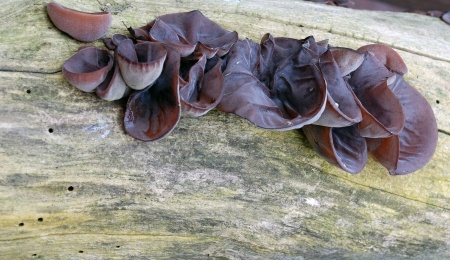Jelly Ear Fungus - Auricularia auricula-judae

Common Names: Jelly Ear, Jew's Ear, Wood Ear, Black Wood Ear, Auricularia auricula-judae, Ear Fungus, Judas's Ear, Cloud Ear, Tree Ear, Auricularia, Black Fungus, Boltcovitka ucho Jidášovo, Boltcovitka bezová
Latin Name: Hirneola auricula-judae (Auricularia auricula-judae)
Origin: Asia, Australia, Europe, North America
Short Introduction
Chopped straw, sawdust, or corn cobs are soaked in water for a day, drained, and filled two-thirds full into bags. The bags are sealed and boiled in a large pot for about 1 hour. Once cooled, jelly ear inoculant (easily available) is prepared by shaking and checking for contaminants. The inoculant is added to the bag, which should not be tightly sealed. Store at 25°C—light is not required. The mycelium forms in a few weeks. Place the substrate in a warm spot. Fruits best at 25–30°C, preferably in a greenhouse, under plastic, or in an aquarium jar. Sufficient indirect light is essential for fruiting. Harvest only healthy, well-shaped fruiting bodies; avoid picking green or white, unhealthy specimens. Clean and dry the harvested fungi, which turn black upon drying. Jelly Ear can also be cultivated outdoors; however, using a greenhouse or polytunnel is easier to maintain optimal temperatures. Elder logs are cut to 1 meter lengths, drilled at 15mm diameter and 20mm deep holes spaced about 10cm apart, filled with inoculant, and sealed with melted wax. Store the logs in a greenhouse (ideal conditions: 30°C and humidity). Full colonization takes 30–40 days. Fruiting continues for 3–6 years, depending on wood quality. Adequate light and moisture must be maintained.
Detailed Description
The Jelly Ear Fungus is a commonly found mushroom that was until recently considered inedible. New research attributes it with anti-cancer, blood sugar and cholesterol-lowering, and anticoagulant properties—making it beneficial for issues like thrombosis, varicose veins, and inflammatory diseases of the veins.
Botanical Information
This widespread, edible, basidiomycete fungus mainly grows on elder trees. The fruiting bodies of Jelly Ear are shelf-like, cup- or ear-shaped, convex upwards, and laterally attached to the wood, typically measuring 2–10 cm in width. They are notable for their cartilaginous consistency, high elasticity, and sometimes translucent or gelatinous texture. When moist, the mushrooms become sticky to the touch; their inner surface is smooth, while the outer can be slightly hairy and is often wrinkled with vein-like patterns. The coloration ranges from reddish-brown to chestnut-brown, with the underside usually lighter. Fruiting bodies grow in clusters, side by side and stacked above each other.
Origin and Distribution
This fungus is very common across temperate regions and can be found year-round, even in winter, predominantly on living or decaying branches of black elder. Its intriguing name stems from the legend that Judas Iscariot hanged himself from an elder branch, giving rise to the English names Jelly Ear and Jew’s Ear.
Jelly Ear Fungus can be found year-round in temperate regions, thriving on both dead and living wood. In Western culture, it has been used in folk medicine since the 16th century to treat ailments related to sore throats, eye issues, and jaundice.
Originally native to Europe, its popularity has soared in China, where it was exported in large quantities from Australia at the beginning of the 20th century. Today, Jelly Ear Fungus is a common ingredient in Chinese soups and dishes, as well as in traditional Chinese medicine.
Usage / Dosage
Auricularia auricula-judae has been the focus of several scientific studies for its potential medicinal properties. Research conducted in the 1980s highlighted two glucan components with potential anti-cancer effects, tested on mice implanted with 180 sarcomas. Aqueous extracts showed a mild effect, while non-aqueous extracts demonstrated significantly better results, and a strong hypoglycemic effect was observed, lowering both plasma glucose, insulin levels, and urinary sugar. Polysaccharides in the fungus contributed to the reduction of blood sugar absorption from food, considered groundbreaking at the time.
Another prominent property is its anticoagulant (blood-thinning) effect, due to acidic polysaccharides. Compounds derived from these polysaccharides have been described as beneficial in the treatment of thrombosis and diseases resulting from arterial blockages, such as acute myocardial infarction.
Clinical studies investigating Jelly Ear’s anti-platelet activity have highlighted a positive effect in reducing 'bad' cholesterol (LDL) levels, making it one of the few mushrooms known to help with elevated cholesterol.
Historically, herbalists prepared compresses from Jelly Ear Fungus to alleviate eye inflammation and soothe symptoms associated with nasopharyngeal discomfort. Sixteenth-century herbalist John Gerard, in 1597, described a specific use: a liquid extract (prepared by boiling in milk or mashing in beer) sipped slowly to ease sore throats. Carolus Clusius in 1601 wrote about using this fungus as a gargle for curing sore throats, and John Parkinson in 1640 recommended boiling it in milk and mashing it with grapevine as the most effective method.
Its astringent, water-absorbing properties made it valuable in various folk remedies. Records from Scotland and Ireland describe its medical use as a gargle for sore throats and boiled in milk against jaundice. Despite its popularity in older remedies, it was rarely featured in 19th-century cookbooks due to being considered inedible.
Today, Auricularia auricula-judae is enjoyed in kitchens around the world for its delicate, jelly-like texture. While edible, it was long underappreciated in Western cuisine but gained popularity in Britain during the 20th century. It has a mild flavor and works well in a variety of mushroom recipes, though still often regarded as a bland ingredient in the West. The fungus can be dried and rehydrated (swelling dramatically in size); young specimens are best, but all require thorough cooking. Dried pieces can be powdered and used as a thickening agent in soups and sauces.
Active Compounds
Jelly Ear contains a significant proportion of polysaccharides, which account for many of its medicinal effects. These acidic polysaccharides mainly comprise mannose, glucose, glucuronic acid, and xylose. Glucan components have also been confirmed.
Traditional Dosage
As previously mentioned, Jelly Ear Fungus needs to be cooked thoroughly. It is used in savory meat dishes, soups, cabbage salads, and offers wide versatility as a culinary delicacy.
